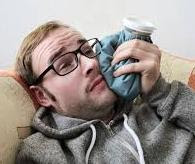Toothache can range from a mild ache to a continuous throbbing pain. Tooth decay, usually due to poor dental hygiene, is the most common cause, but pain in the teeth can also be due to gum disease, a cracked tooth, or jaw problems. Teenagers and adults may have pain from wisdom teeth emerging. Your teeth may become sensitive to hot or cold or to brushing if the enamel that protects them becomes worn or cracked, or if your gums recede and expose the inner layers of the teeth.
See your dentist first
Make an appointment to see your dentist if you are suffering from toothache.
NATURAL REMEDIES
Oil of cloves is a traditional remedy from your pharmacist that may help to soothe an aching tooth. Put a few drops of the oil on a piece of cotton wool, place it on the painful tooth, and bite down gently. Be careful to keep the oil off your tongue because it may burn a little.
Clove oil
The oil is distilled from cloves and is antiseptic and anesthetic, which makes it useful for relieving toothache.
DRUG REMEDIES
Painkillers for toothache include paracetamol and ibuprofen (see p 184). Try a stronger combined painkiller, such as paracetamol and codeine, if your tooth is very painful.
* For a child, give paracetamol or ibuprofen to relieve pain and discomfort. They are available in various forms and your pharmacist will advise which is most suitable for your child.
What you can do yourself
Take the following steps to relieve a painful tooth while you are waiting for an appointment with your dentist, or to reduce general sensitivity in your teeth.
* Avoid eating or drinking anything very hot or very cold if this makes the pain worse. Some people, however, find that sucking on an ice cube in the area of the toothache brings relief. Stop if the tooth becomes more painful.
* Rinse your mouth thoroughly with a salt water mouthwash. To make it, mix a teaspoon of salt in a cup of warm water.
* Try applying oil of cloves to a painful tooth.
* Take a painkiller such as paracetamol or ibuprofen.
* Use dental tape or floss to remove any food debris trapped between your teeth. Gently clean either side of the painful tooth.
* If you have sensitive teeth, brush your teeth gently using toothpaste formulated for sensitive teeth. After brushing, massage a little toothpaste into your gums and leave it on overnight.
* Establish a good oral hygiene routine to prevent further tooth decay
Knocked-out tooth
Teeth are often knocked out during accidents, particularly during contact sports such as rugby. The front teeth are the most vulnerable. If you lose one of your permanent teeth, you may be able to save it by replacing it quickly and getting emergency help.
If a tooth is replaced in the socket within about 30 minutes of being knocked out, there is a 90 per cent chances are still good for up to 2 hours. A broken tooth, however, cannot be saved. Children sometimes lose baby teeth in a fall, but these will be replaced eventually be permanent teeth so there is no need to replace them.
Seek immediate medical advice
If your tooth has been knocked out or loosened by an injury, see your dentist or go to an Accident and Emergency department as soon as possible. If a child loses a baby tooth, it is important to see a dentist to check for possible damage to the mouth or gums.
PRACTICAL TECHNIQUE
Replacing a tooth Whenever possible, you should try to save a permanent tooth by replacing it quickly in the socket. Don’t attempt do this, however, if you are concerned that the casualty may swallow or choke on the loose tooth.
* Wash your hands thoroughly or put on disposable gloves, if available. Pick up the tooth by the crown hand hold it firmly. Check that it is the right way round before pushing it firmly into the socket. Do this even if the socket is bleeding.
* Hold the tooth in place with your fingers, or put a piece of gauze on the tooth and bite down gently on it. Go to a hospital Accident and Emergency department or an emergency dentist for immediate treatment.
What you can do yourself
Immediately after the accident, take the following steps to maximize the chances of saving your tooth. Replacing the tooth is the best option, but if you can’t do this, you must make sure that the tooth does not dry out while you seek medical help.
* Find the missing tooth and pick it up by the top (the crown), not the root. Do not rub or scrape it to remove dirt or any tissue fragments attached to it. Rinse it gently in a glass of tap water, but don’t hold it under running water.
* Put the tooth back in its socket
* If you can’t replace a permanent tooth in its socket, tuck it under your tongue or inside your cheek. Alternatively, place the tooth in a glass of milk or some of your own saliva.
* If a child has lost a milk tooth and the socket is bleeding, rinse out his or her mouth with water and place a wad of tissue or gauze in the socket. Your child should bite down on it to stop the bleeding.

